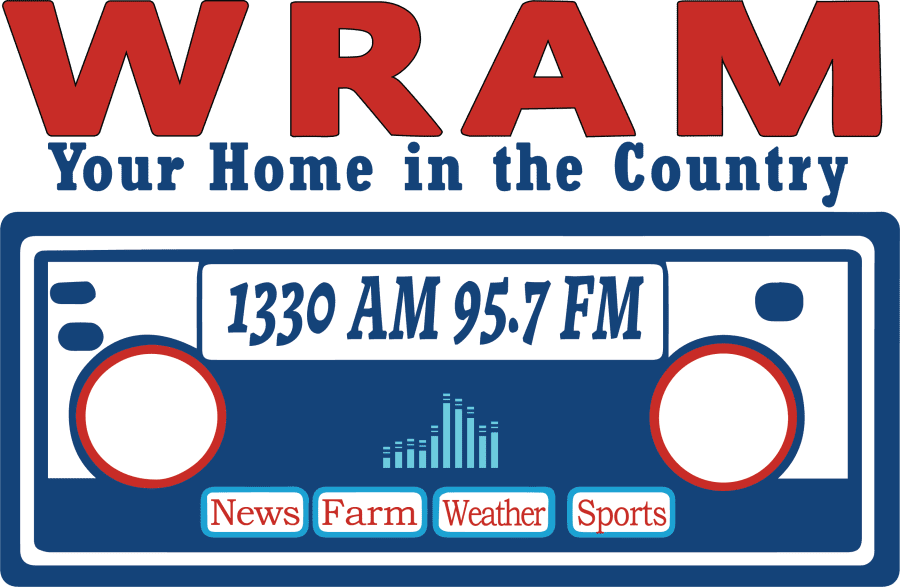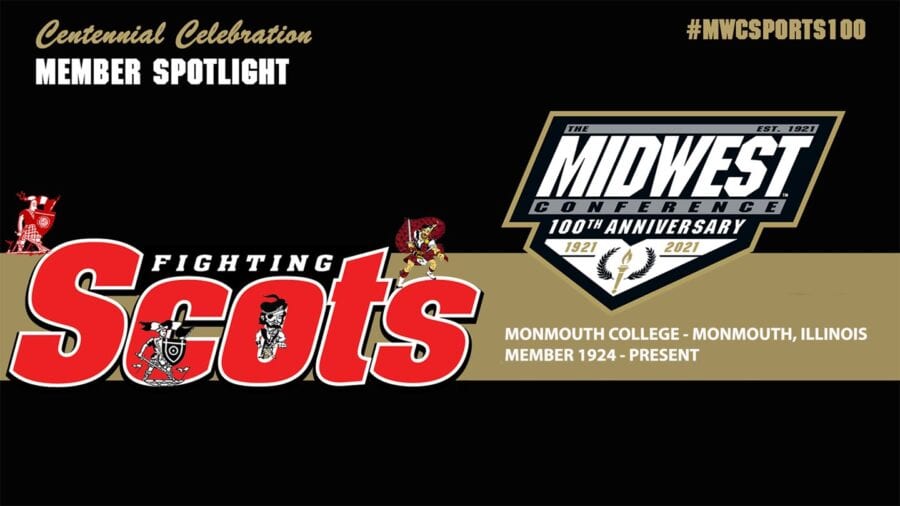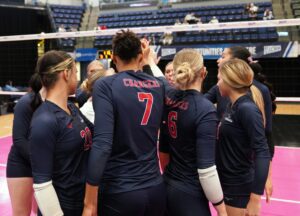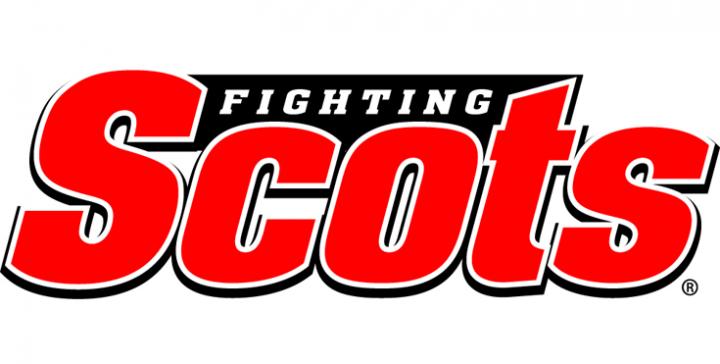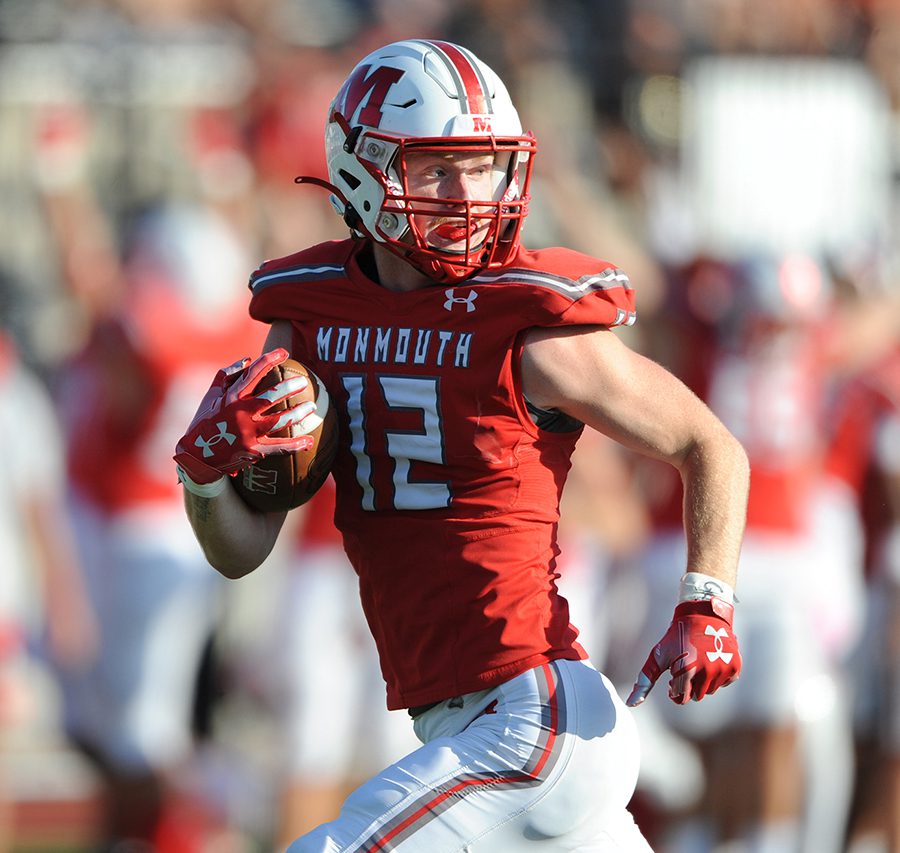Members of the Midwest Conference are taking center stage on the league’s website this fall as the MWC celebrates its Centennial Year. The history of Monmouth College athletics, now in its 152nd year was the featured institution in mid-November.
In the Beginning
The advent of the 20th century witnessed the origin, development and evolution of athletics into an integral part of the educational experience at colleges and universities across America, and Monmouth College was no exception. Despite tremendous changes in rules, equipment and recruiting since baseball became Monmouth’s first official team in 1868, intercollegiate sports remain a vital opportunity for college student-athletes.
Monmouth and the NCAA and Conference Memberships
Monmouth has been a member of the National Collegiate Athletic Association (NCAA) since the organization’s inception in 1910. The college has been an NCAA Division III (non-scholarship) member since the three-division system was adopted in August of 1973.
On the regional level Monmouth’s athletic teams initially competed in the Illinois Intercollegiate Athletic Association until 1901 but the college’s first entry into actual conference competition came in 1910 with the formation of the Athletic Conference of the Middle-West. This league eventually changed its name in 1914 to the Little 5 Conference to accurately reflect its membership. The conference eventually dissolved in 1920, opening the door for Monmouth to join the fledgling Midwest Conference four years later.
Monmouth also held brief affiliations with several other organizations in the early years of the century including the “Little 19 Conference,” which included almost all colleges and universities in the state of Illinois.
Monmouth’s long-term conference affiliation with the Midwest Conference was stabilized in 1924 when it accepted an invitation to join the fledgling league, an association which would later become the Midwest Conference. Since joining the MWC, the Fighting Scots have won more than 150 team and 1,000 individual conference titles.
The Origin of Organized Sports
Founded in 1853, Monmouth, like most other colleges in their infancy, showed little interest or money for sports in the early years. Nearing the turn of the century there became a more urgent desire for some sort of organized form of sport activity for students.
The intercollegiate athletic program at Monmouth traces its origins to 1868 when the first official contest was played. Monmouth’s baseball team opened the new era with a 74-27 victory over Lombard in the fall of 1868. The teams played three more times that fall, but never matched the inaugural offensive output.
The first football game was played in 1888 against Knox College and began a gridiron rivalry that continues to this day as the sixth longest-running rivalry in the nation in all college divisions and the third longest in Division III. Due to its larger participation numbers and popularity, football quickly supplanted baseball and track as the main athletic activity and eventually caused the elimination of baseball as a fall season sport.
Monmouth’s next official sport, track and field, was first recognized in the 1898 edition of the Ravelings yearbook. The turn of the century saw the introduction of basketball, a sport the 1901 annual recognized as “fast becoming one of the most popular American games.” These four major sports – football, basketball, track and baseball – helped to feed interest in joining a league with other schools in order to expand the opportunities for all of the newly-formed teams.
Internal Control and Administration
The college established its first Athletic Board of Control in the fall of 1901 which was composed of two students, two trustees and one faculty member. The board’s primary responsibility was to govern the individual sports and all their personnel. This group remained in effect until the mid-1940’s.
Upon entry into the Midwest Conference in 1924, Monmouth hired Herbert L. Hart as football coach and athletic director. Hart stayed at Monmouth for 14 years and was the department’s first long-term athletic director. The M-Club, Monmouth’s varsity letterwinner organization which was founded in 1921, grew during Hart’s years. In the 1930’s the number of coaches also grew to reflect the increase in athletics.
The department received a huge benefit when Bobby Woll joined the coaching staff near the end of Hart’s tenure. Woll, the only Monmouth football player to have his jersey retired, ended his playing days in 1934 and immediately began a 40-year coaching career at Monmouth. His relationship with the Athletic Department and involvement in the business of the college continued until his death in 1999. Under the direction of Woll and Glenn “Jelly” Robinson the athletic program survived the lean years when most men were called into service during World War II. Woll held the position of athletic director throughout the 1940’s and he and Robinson were the mainstays of the Fighting Scot coaching staff during this time.
Charles Larson led the department into the 1950’s and stayed as athletic director through 1962. The AD position was held by Henry Andrew (1965-71), Jack Steger (1971-76) and Woll for two more short stints before Terry Glasgow was promoted to that position in 1978. Glasgow, who was instrumental in solidifying the position of women’s sports at Monmouth, was originally hired as basketball and baseball coach in 1972. He served as athletic director until his retirement in the spring of 2008.
Monmouth alum Roger Haynes took over as AD when Glasgow retired in 2008. Haynes follows in the footsteps of Bobby Woll, who came to Monmouth as a student and stayed as a coach and administrator.
Athletic Facilities
The call for adequate facilities dates back to the early days of intercollegiate athletics at Monmouth.
Despite continued pleas for improvements to fields and buildings, it was not until 1925 that a permanent gymnasium was constructed on campus. Daniel Everett Waid, an 1897 graduate of Monmouth College and a New York City architect, donated over $80,000 toward the project and oversaw its design. The new building was aptly named in honor of Waid.
Waid Gymnasium, with its hardwood playing floor for basketball, indoor swimming pool (which Waid donated), stage, movie booth, locker rooms and 100-yard running track, opened with a men’s basketball game between Monmouth and Coe on February 21, 1925. The Fighting Scots appropriately won that game in overtime 28-26.
Waid Gym played host to Fighting Scots basketball, swimming, wrestling and volleyball competition for almost 60 years and is now part of the Huff Athletic Center and houses locker rooms, a training room and health and fitness center.
In 1982 ground was broken on the south end of Waid Gymnasium for another athletic building and a year later Arthur Glennie Gymnasium was opened. The first college contest in the new gym was actually a volleyball match, a three-set victory for Monmouth over conference rival Grinnell in September of 1983. The first men’s basketball game in Glennie Gymnasium also resulted in a Fighting Scot victory as Monmouth defeated Cornell 87-73 in their 1983-84 home opener. The Monmouth women made it a clean sweep of home victories, winning their inaugural basketball game in the new facility against Blackburn.
Another new athletic facility opened in 2003 with the addition of the $22 million Huff Athletic Center. Simply referred to by Monmouth’s students as “The Huff,” the facility houses a 200-meter indoor track, swimming pool, tennis and basketball courts and batting cages. Men’s and women’s water polo, two sports added in 2013, also take advantage of the new aquatics area.
Football games have been contested on campus nearly as long as the sport has been played at the college. As the campus grew and changed over the years, the actual playing field site was moved several times until the present field was finished. Bobby Woll Memorial Field, named in honor of one of the college’s greatest all-around athletes and coaches, was dedicated on October 18, 1980. The first game played resulted in a 21-0 loss to Ripon in the 1981 home opener.
Nearly 30 years later, in 2008, the stadium received the first of a three-phase makeover. Phase I included construction of new stadium seating and press box. Phase II saw the installation of artificial turf and permanent lighting. Phase III added a video display scoreboard. The new facility was completed and dedicated in the fall of 2009. The stadium itself was renamed April Zorn Memorial Stadium in memory of April Zorn Huff ’59 whose husband, Walter S. Huff Jr. ’56 made the lead donation for construction of the $4.2 million facility. The actual field, featuring artificial turf, remains as Bobby Woll Memorial Field.
In addition to football, the stadium is also home to the Fighting Scots men’s and women’s track and field teams. In 2017 men’s and women’s lacrosse was added, making Zorn a heavily used venue in the spring.
Softball got its own diamond adjacent to the football stadium after many years of playing at various city locations and a compact diamond on campus. Renovations on the softball field, which had been the home diamond for the baseball team, were begun in 1998 and the new diamond saw its first competition in 1999.
A generous donation to the athletic department in the late 1990’s allowed for the construction of a new baseball diamond and two soccer fields. Peacock Memorial Athletic Park saw its first intercollegiate action during the 1999-2000 athletic seasons.
The Wartime Years
The unprecedented conditions resulting from World War II disrupted every college campus and Monmouth was no exception, losing a large majority of its male population to the military service in the early 1940’s. Through the years of 1942-1946 several sports at Monmouth were canceled due to a shortage of participants. Due in large part to a temporary influx of servicemen in the U.S. Navy’s V-5 flight training programs the college was able to field athletic teams in basketball and track. However, the Navy outlawed its servicemen from football so no games were played in 1943 or 1944.
During the war, thousands of students from the nine Midwest colleges were in uniform, among them hundreds of athletes who played leading roles in all branches of the military service, including Monmouth’s Bobby Dunlap, a Medal of Honor winner for his actions in the battle for Iwo Jima.
Fighting Scots Mascot
The earliest athletic teams at Monmouth College did not carry any special names or loyal mascots. News reports and yearbook stories referred to “the Monmouth eleven,” “Monmouth nine” or simply described the athletic exploits by common adjectives, such as gridders, thinclads and roundballers. After Monmouth entered the Midwest Conference in 1924, the college’s students voted in 1928 to adopt the nickname “Bulldogs” for the athletic teams, but due to recent graduate Harold Hermann’s efforts of to celebrate the rich Scottish heritage of the college, “Bulldogs” was short-lived.
Hermann, a Class of 1927 graduate who worked in the Alumni Relations and Sports Information offices after completing his degree, knew of the rich Scottish background of the college, founded in 1853 by local residents of Scottish-Presbyterian decent.
Upon learning of the student vote on the college mascot, Hermann immediately set out to campaign for a name change. Since Hermann handled the sports information duties he was perfectly positioned to refer to the college’s athletic teams as the “Fighting Scots”, a name he chose to describe all of the teams in print and press releases. The local newspaper media and press gradually picked up on the moniker and it wasn’t long before Monmouth officially adopted the Fighting Scots as its nickname and mascot.
Hermann continued his mission to revive the strong Scottish heritage of the college by selecting visible symbols worthy of the Fighting Scots before leaving Monmouth in 1944. He chose the red and white Menzies Plaid as the first official tartan, replaced the green freshman beanies with tartan caps and brought the first bagpiper to campus from Chicago. While the freshman beanies were eventually discontinued, the bagpiper concept caught on and would evolve into the traditional Pipes and Drums corps, which plays at graduation and other major college functions including many sporting events.
Though several different versions of a Scotsman mascot have been used on college publications, logos, letterheads and signs throughout the years the “Fighting Scots” nickname has remained as the descriptive term for all Monmouth athletes and their teams.
***Story courtesy of Monmouth College Athletics***

